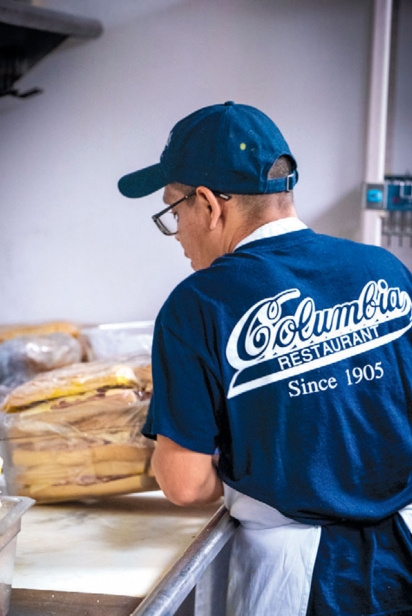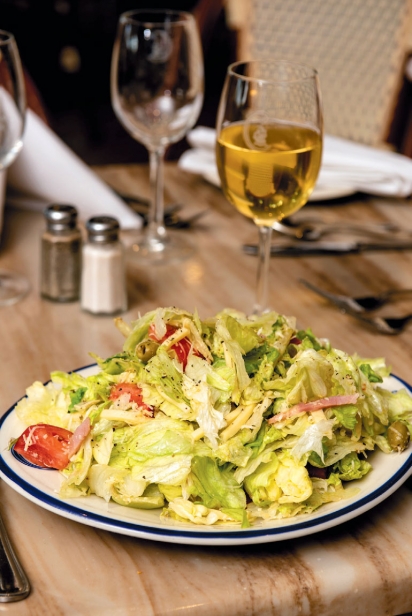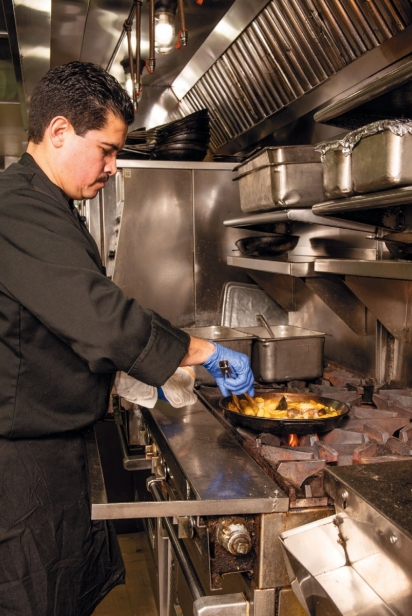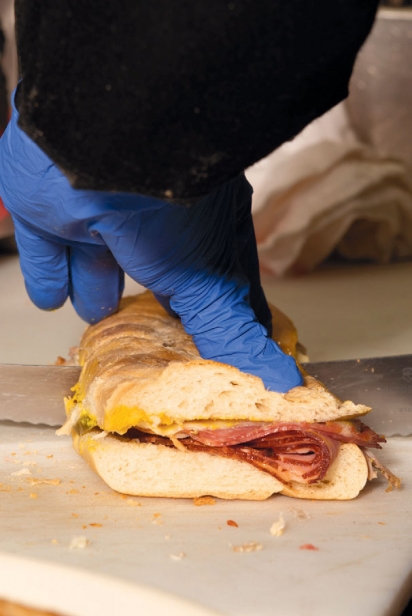Century of Service Columbia Restaurant
It’s a few minutes until the hungry wave of lunch customers crashes ashore at Columbia Restaurant in St. Armands Circle. Executive Chef Jesus Padilla and his support cooks are a blur of activity. One pours caramel flan into dozens of individual cups headed for the oven. Another stirs a kettle of slow-roasting pork with what looks like a giant metal boat oar. When he isn’t doing that, he’s mixing the ingredients for devil crab croquettes in a saute pan. A third begins assembling Cuban sandwiches for the day, stacking them like delicious bricks in preparation for crisp pressing in a preheated plancha.
The kitchen echoes with the clanging of plates and pots and pans and dishes and glasses being racked, cleaned, and unloaded by a dishwasher who appears to have eight arms.
Standing over a stove amid the closet-width cooking line, Padilla mixes a pan of grouper, squid, chicken breast, pork loin, mussels, clams, scallops, and shrimp with vegetables and rice to make the menu’s signature Paella “A La Valencia.” A squadron of paella pans dangles above a corner of the boomerang-shaped kitchen.
You can’t rush this dish; the Columbia menu full of Spanish and Cuban delights warns customers that each order takes at least 30 minutes to prepare. Just enough time to enjoy the restaurant’s world-famous “1905” Salad, maybe a pitcher of fresh-mixed sangria, and an irresistible helping of fresh-baked La Segunda Cuban bread still warm from the oven. Also tempting the hungry: a plate of meaty stone crabs harvested seasonally from the Gulf, which is only a few blocks away on Lido Beach. Food this comforting should come with a sleep number.
There is no panic in the kitchen, nor in the dining room, where a small army of servers, bartenders, and runners in pressed white dress shirts and neckties drape themselves with aprons to prepare for service while the “directors of first impressions” (aka hosts) review the day’s reservations. There are 400 seats in two main dining rooms, the bar and dozens of sidewalk tables. The restaurant will fill and empty numerous times by the time it closes that night. Padilla is in his 19th year at Columbia and isn’t within sight of the longest-serving employee, Caren Link, who in February will mark 39 years behind the bar.
The choreography is well-rehearsed. In 2019 this restaurant, the oldest in Sarasota and owned by the same Tampa-based family for five generations, celebrates 60 years of doing business on St. Armands Circle. It was the first successful location to establish away from the original Columbia, which was founded in 1903 as a saloon in Ybor City.
What’s the longevity secret? The answer, says fourth-generation co-owner Casey Gonzmart Sr., is true despite being a cliche: location, location, location. St. Armands Circle is the destination crossroads between Sarasota, Lido Beach, and Longboat Key that visionary circus magnate John Ringling envisioned when he purchased the property in 1917, back when it took a steamboat to get to the island.
“But the people who come to St. Armands today don’t know if we’ve been there for 60 years or for six,” Gonzmart says. “We’re consistent in our timeliness and in exceeding customer expectations. They come back generation after generation because we’re always evolving while staying true to our roots.
“We’ve always thought we were a restaurant before we were a Spanish restaurant.”
Gonzmart received an earnest call from his father, Cesar, one day in 1971. Shortly thereafter, he visited his parents, who sat him down and explained that the general manager of the Sarasota Columbia had been fired.
Cesar explained that they needed Casey in Sarasota to manage the restaurant. “I asked them when,” Casey remembered, “and they said, ‘Tomorrow.’”
Having just returned from school overseas in 1970, he was more interested in catching up with friends than in managing an underperforming restaurant in what was seen at the time as a restaurant backwater. Open for 12 years at that point, the Columbia was still struggling to maintain business during the long months when snowbirds weren’t pouring money into the local economy.
When Casey’s cautious grandfather Casimiro Hernandez Jr. signed the papers with his big-dreaming son-in-law Cesar for a 50-year lease in 1959, St. Armands was struggling. An Exxon gas station filled one corner of the circle. A hobby store sold toy trains in another space amid a small number of owner-operated shops. When Casey took on management of Columbia Sarasota, a nightclub named Big Daddy’s operated down the street with go-go dancers gyrating in cages.
Humbled by false starts in Orlando and on Tampa’s Rocky Point and with urban renewal taking bites out of profits in the home neighborhood in Ybor City, Cesar prepared for a new adventure. Sarasota seemed like a strange choice for the location of a fine restaurant. Columbia had problems operating one restaurant, his father-in-law reasoned. How could they have two restaurants, much less one in a town that was only half-awake?
“At that time, Florida wasn’t ready for business year-round,” he said. “It was the right place but a little too soon. My dad and my grandfather, their crystal ball was a little clearer than other people’s.”
If opening the restaurant was a risk, operating it was an even bigger hurdle. Casey described the Sarasota of yesteryear as “physically, ethnically, and psychologically another world from Ybor City.”
Spanish ingredients like garbanzo and black beans and Spanish sausage could not be obtained at any store near Sarasota. Those edibles were as foreign as moon rocks. Ethnic food distributors wouldn’t waste time hauling supplies to deserted beaches. Every day, workers at the Columbia in Ybor loaded a flatbed truck with exotic ingredients and coffee for their sister restaurant to the south.
Management imported workers from Tampa to open the restaurant. Over time, Cesar recruited workers from Cuba to staff it. Only a few locals could cut it in the Spanish “kitchen madhouse” where servers would take turns shouting orders at cooks and a hierarchy of waiters determined who served the most desirable and profitable tables.
In the days before the Sunshine Skyway Bridge and Interstate 75, employee George Guito drove U.S. 41 by way of Gibsonton and Rubonia from Tampa to supply the restaurant as if it were an outpost somewhere out west. If you took the donkey trail and it was in the winter season, you probably took forever to come and go.” Workers at the Sarasota restaurant spent many an hour waiting for the daily truck to arrive. The tenuous supply line kept the restaurant alive.
As recently as the mid-1990s, John Monetti, Columbia Sarasota’s current general manager, would drive to Cortez with a cooler to pick up fresh stone crab each day.
“We had three or four different sources of stone crab,” Monetti says. “Finally I honed in on this guy who seemed more consistent. Twenty years ago, I said, ‘I’m buying from you and give me everything you’ve got.’ And he does to this day.”
Stone crabs were an early magnet Gonzmart used to draw crowds, even setting up a sidewalk corner shop selling claws on ice to passersby. It helped greatly that the crustaceans’ season—which runs from mid- October until mid-May—matched the seasonality of the big-spending tourists and winter residents in the neighborhood hugging the circle.
Before stone crabs, Gonzmart used live entertainment to lure customers starved for fun on the sleepy key. His father, Cesar, a concert violinist, employed the same tactic at the Ybor City restaurant’s Siboney dining room, performing with Casey’s mother, Adela, a Juilliard-trained pianist, in front of tuxedoed gentlemen and their fur-wearing dates.
Casey sought out music of his own. “We thought of flamenco and things like that. The history of the Columbia in Ybor City hadn’t been dancers; it had been orchestras, bands that played for the customers to dance. So in another strange way, history kind of repeated itself, because rather than trying to have performances, we started very small with just a single entertainer.”
The entertainment evolved into duos and trios. At 9 each evening, the venerable Columbia would become a trendy disco called The Patio. “Some people would go to The Patio at night and not know it was the Columbia Restaurant.”
Casey operated with complete autonomy. He and his staff created the recipes, implemented management decisions and remodeled at will. His chef, Frank Lorenzo, came from Cuba. Known as “Guantanamo,” Frank had served there with the Navy. “We had our own recipes,” Casey said. “It had the same name as the item in Tampa, but it was made like Frank Lorenzo would make it.”
Casey wanted to further adapt the restaurant to Sarasota’s social climate. By the mid-1980s, music was lowered in priority at Sarasota. Inspired by his travels, Casey made a special effort to feature fresh seafood. He created an oyster bar to heighten the link in customers’ minds that Columbia featured local food.
Some menu hits took longer to establish than others. The restaurant’s iconic “1905” Salad, named “One of America’s Top 10 Best Salads” by USA Today, barely registered in Sarasota when it was introduced in the early 1970s in Ybor City to match the salad bar craze.
The Sarasota restaurant would get calls from customers asking if they had a salad bar. They had none—but the 1905 Salad already was on the menu. Few tasted it, though, because the restaurant already provided a garden salad with each entree. As the craze got stronger, Casey switched to a side of 1905 for no extra charge. Chef Lorenzo also added black olives and celery to the salad, ingredients Ybor omitted.
“We literally got tens of thousands of tastes of something that had been there all the time,” he said. “People began ordering it as an entree. That was the home run. When we opened in Sarasota, it was on the menu but you probably could have counted on one hand how many we sold.
“We became the place to eat stone crab, not just the place to have a Cuban sandwich or the place to have paella. We were the place that people came and danced at night an until 3 in the morning,” he said. “We were the place that people came and had seafood at the bar or at the table. Great food prepared by a wonderful chef. The timing was incredible.”
Casey’s keen observation of Sarasota’s clientele over the years served Columbia well. The reluctant manager became his own man in Sarasota over three decades. “My three older children were born in Sarasota, and then I just embraced it, my friendships.”
Tourists came by the thousands from Germany and the British Isles. The Europeans wanted badly to dine al fresco in the dog days of Florida summer. Mystified but determined to provide outdoor seating, Casey ran into an immediate obstacle. A county code made it illegal for a restaurant to serve food outside. The officials who thought it up assumed any food taken out of doors would be “contaminated.” County officials amended the measure by allowing Columbia to serve covered dishes. By uncovering their own food, patrons became legally responsible for the risk of contamination. Laws to curb the dangers of dining outdoors have since relaxed.
In an effort to cash in on outdoor dining, Casey proposed renovations to the landlord. Columbia would pay for the improvements and the landlord would own them. The landlord denied the proposal. Al fresco dining waited until a new investor bought the property.
“Home run,” he said. “Everybody wanted to sit outside. Even though the biggest thing to happen to the Columbia in Ybor City was introducing air conditioning, the most important thing to happen in Sarasota was sitting outside in the hot sun. I don’t know why, but the Europeans loved it.” Stationary windows on The Patio were converted to sliding doors. Today, more than half of the Sarasota restaurant consists of indoor-outdoor seating.
Columbia’s Sarasota colony took more than 30 years to blossom. Today it is a pillar of the 13-store Columbia Restaurant Group empire, which includes seven Columbia locations as well as sister restaurants Ulele, Goody Goody, Cha Cha Coconuts and Cafe Con Leche Ybor City.
Columbia’s appeal, generations later, now seems as bright as Sarasota sunshine in St. Armands Circle.
“You can walk two blocks off Lido Beach in your bathing suit and cover-up and wearing flip-flops and stop in the finest restaurants, enjoy professional service, and then go back to what you were doing,” Gonzmart says. “Where can you get that?”
Portions of this story were excerpted from “Columbia Restaurant: Celebrating a Century of History, Culture, and Cuisine” by Andrew Hues.












